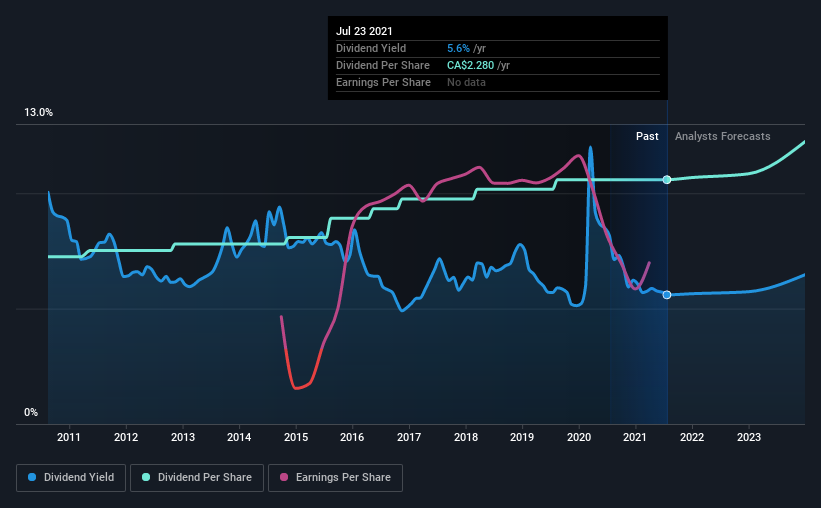Here's Why We're Wary Of Buying Exchange Income's (TSE:EIF) For Its Upcoming Dividend
Some investors rely on dividends for growing their wealth, and if you're one of those dividend sleuths, you might be intrigued to know that Exchange Income Corporation (TSE:EIF) is about to go ex-dividend in just four days. Typically, the ex-dividend date is one business day before the record date which is the date on which a company determines the shareholders eligible to receive a dividend. The ex-dividend date is an important date to be aware of as any purchase of the stock made on or after this date might mean a late settlement that doesn't show on the record date. Accordingly, Exchange Income investors that purchase the stock on or after the 29th of July will not receive the dividend, which will be paid on the 13th of August.
The company's next dividend payment will be CA$0.19 per share, and in the last 12 months, the company paid a total of CA$2.28 per share. Based on the last year's worth of payments, Exchange Income stock has a trailing yield of around 5.6% on the current share price of CA$40.74. Dividends are an important source of income to many shareholders, but the health of the business is crucial to maintaining those dividends. We need to see whether the dividend is covered by earnings and if it's growing.
Check out our latest analysis for Exchange Income
Dividends are typically paid from company earnings. If a company pays more in dividends than it earned in profit, then the dividend could be unsustainable. Exchange Income distributed an unsustainably high 199% of its profit as dividends to shareholders last year. Without more sustainable payment behaviour, the dividend looks precarious. A useful secondary check can be to evaluate whether Exchange Income generated enough free cash flow to afford its dividend. Over the last year it paid out 61% of its free cash flow as dividends, within the usual range for most companies.
It's good to see that while Exchange Income's dividends were not covered by profits, at least they are affordable from a cash perspective. If executives were to continue paying more in dividends than the company reported in profits, we'd view this as a warning sign. Very few companies are able to sustainably pay dividends larger than their reported earnings.
Click here to see the company's payout ratio, plus analyst estimates of its future dividends.
Have Earnings And Dividends Been Growing?
Businesses with shrinking earnings are tricky from a dividend perspective. If business enters a downturn and the dividend is cut, the company could see its value fall precipitously. Readers will understand then, why we're concerned to see Exchange Income's earnings per share have dropped 6.8% a year over the past five years. Such a sharp decline casts doubt on the future sustainability of the dividend.
Many investors will assess a company's dividend performance by evaluating how much the dividend payments have changed over time. In the past 10 years, Exchange Income has increased its dividend at approximately 3.9% a year on average. That's intriguing, but the combination of growing dividends despite declining earnings can typically only be achieved by paying out a larger percentage of profits. Exchange Income is already paying out a high percentage of its income, so without earnings growth, we're doubtful of whether this dividend will grow much in the future.
The Bottom Line
Has Exchange Income got what it takes to maintain its dividend payments? It's never fun to see a company's earnings per share in retreat. What's more, Exchange Income is paying out a majority of its earnings and over half its free cash flow. It's hard to say if the business has the financial resources and time to turn things around without cutting the dividend. Bottom line: Exchange Income has some unfortunate characteristics that we think could lead to sub-optimal outcomes for dividend investors.
With that in mind though, if the poor dividend characteristics of Exchange Income don't faze you, it's worth being mindful of the risks involved with this business. For instance, we've identified 4 warning signs for Exchange Income (1 is significant) you should be aware of.
A common investment mistake is buying the first interesting stock you see. Here you can find a list of promising dividend stocks with a greater than 2% yield and an upcoming dividend.
This article by Simply Wall St is general in nature. It does not constitute a recommendation to buy or sell any stock, and does not take account of your objectives, or your financial situation. We aim to bring you long-term focused analysis driven by fundamental data. Note that our analysis may not factor in the latest price-sensitive company announcements or qualitative material. Simply Wall St has no position in any stocks mentioned.
Have feedback on this article? Concerned about the content? Get in touch with us directly. Alternatively, email editorial-team (at) simplywallst.com.

 Yahoo Finance
Yahoo Finance 
